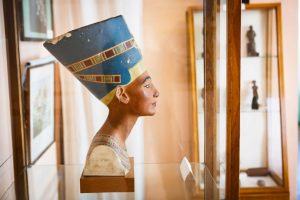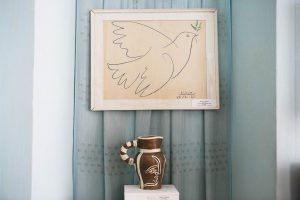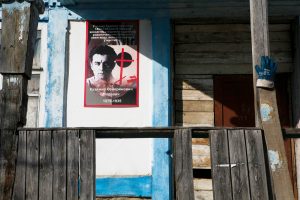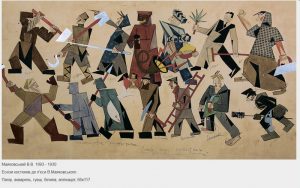Small and remote as it is, the village of Parkhomivka, located 100 kilometres from the east-Ukrainian city of Kharkiv, is well known for its art museum that houses a unique collection of masterpieces, namely paintings by such world-famous artists as Pablo Picasso, Camille Pissarro, Kazymyr Malevych, Vasyl Kandinsky, etc.

The museum was founded in 1955 by Afanasiy Panas Luniov, a history teacher of the local secondary school, art collector and art connoisseur.
The current museum director, Olena Semenchenko, has been managing the institution since 2001, when 82-year-old Panas Lunyov resigned due to ill health. However, Ms Semenchenko is not new to the job as she contributed to the development of the museum when she was a young schoolgirl.
A Ukrainian “mini-Louvre” created by schoolchildren
Afanasiy Panas Luniov was born in 1919 in the village of Shcheholiok, Kursk Governorate, Russia. In search of work, his family moved to the Donbas, where he completed his secondary school studies.

He enrolled at the Faculty of History of the University of Kyiv, but was not able to complete his studies because of World War II. In 1941, Luniov was taken prisoner by the Germans and spent the rest of the war in concentration camps.
After returning home, he was appointed as a teacher of history at Parkhomivka Secondary School.

One day, Luniov suggested that the students create a museum of local folklore to better understand the history of their native village. The children were enthusiastic, and began collecting household items, embroidery and paintings by amateur artists in Parkhomivka and the surrounding villages. Subsequently, they held their first exhibit in the classroom and started conducting excursions.
Some years later, the school building became too small for the growing collection, so the museum was moved to a nearby abandoned house. Luniov, who himself was a collector of antiques and art objects, donated his own “treasures” to the museum.
“Panas Fedorovych said that the school lacked an important educational subject; not enough attention was paid to aesthetic education. Therefore, he suggested that children write letters to famous artists and major Soviet museums and ask them to help create a real art museum in Parkhomivka,” recalls museum director Olena Semenchenko
The Union of Kharkiv Artists was the first organization to respond; they donated 50 works of art to the school museum in 1955. Later, the school received other artwork from the Hermitage, the Pushkin Museum of Fine Arts, the Union of Artists of the USSR, etc.

Several major Soviet cities invited the children to visit their museums, artists’ workshops and exhibits. The authorities of these cities also talked to artists and invited them to join in the creation of the Parkhomivka Art Museum. Thus, artists, collectors and museums from all over the Soviet Union began transferring works of art to the village.
“Panas Fedorovych founded a group called the Young Historians, but it was later renamed the Rainbow Art Club. Our 7th-10th grade students did all the museum work and conducted excursions. The directors were also our students. Of course, all this took place under the guidance of Panas Fedorovych, but the children were given a lot of responsibility and they really appreciated it,” continues Olena Semenchenko.
Over the years, the museum collection grew and needed to be itemized and registered. In 1986, Luniov decided to transfer the exhibits to the state. Parkhomivka became an independent department of the Kharkiv Art Museum, and the collection became part of the state fund of the Ministry of Culture.

The building, which houses the museum, dates back to the late 18th-early 19th century. At one time, it belonged to the Kharytonenko family, prominent Ukrainian philanthropists and sugar magnates from Sumy. The Kharytonenko family usually spent their holidays in Parkhomivka and at their nearby estate of Natalivka.
After the 1917-18 Bolshevik Revolution, the estate premises were used for various purposes. Since 1963, the museum has occupied eight halls on the first floor, and invested the entire second floor in 1997.
Picasso, Shevchenko, Aivazovsky & Repin
Today, the Parkhomivka Museum collection has over 7,500 objects on display. The exhibit is very diverse and includes paintings, graphics and applied arts from different countries and eras.
Here you can admire 17th-19th century icons, aquarelles by Ivan Aivazovsky and Oleksandr Ivanov, a portrait by Ilya Repin, pencil sketches by Ivan Shyshkin and Taras Shevchenko, landscapes by Isaac Levitan, and Nicholas Roerich’s Church Etude.

There are also ancient Egyptian statuettes from the tombs of the pharaohs and other oriental artefacts, such as an exact copy of the Nefertiti Bust, which was donated to the museum in 1965 by the staff of the Dresden Art Gallery.

The collection of Western European paintings is especially impressive – works by Dutch artists of the 17th century, including Portrait of a Young Girl by Rembrandt’s pet student Ferdinand Bol and Le Printemps, one of the last works of the famous French Impressionist Camille Pissarro.
“Due to a progressive eye disease, Camille Pissarro could not work in the open air, so he often painted landscapes from the window of his room or hotel. This canvas shows a seemingly inconspicuous corner of a courtyard and the wall of a neighbouring house. Just look at the wonderful play of light and shadow! Pissarro was able to capture a wonderful spring morning.” points out Olena Semenchenko.

The museum also has four works by Pablo Picasso: a portrait of physicist Frédéric Joliot-Curie, the famous Dove of Peace and two ceramic pieces – a jug (Man and Owl) and a plate Diver. The paintings were presented to Luniov’s students by Picasso’s old friend, Soviet writer Ilya Ehrenburg, and the ceramic works were donated by the Pushkin Museum.
“Our students corresponded and met with Ilya Ehrenburg, who was a great friend of Picasso. The artist gave him these works. When he found out about our museum, he came to visit and talk with the students. It was then that he decided to donate these two works.” adds Olena.


Ukrainian avant-garde artists
Parkhomivka is very proud of its collection of avant-garde art pioneers: Suprematism 65 by Kazymyr Malevych, the only work of the founder of Suprematism in a Ukrainian museum, and two paintings by Vasyl Kandinsky. These masterpieces were donated to the museum by Luniov himself.

“Panas Fedorovich never said a word about the origin of these two works. Malevych’s paintings were not appreciated by the Soviet regime; they were to be destroyed, sold or removed from museums,” underlines Olena.
Kazymyr Malevych’s name is closely connected with Parkhomivka. In 1890, the Kharitonenko family invited his father Severyn to work at the local sugar factory. Malevych Sr. knew how to refine sugar, i.e. he knew everything you need to know about the sugar industry, and was ready to work for a much lower salary than certain “certified” specialists. The Malevychs lived in a house that the Kharitonenkos had built in Parkhomivka for their factory workers.

“Kazymyr was 12 years old when the family lived here. He was an ordinary boy and his strange first name did not cause any surprises, because there were many foreigners living and working here. But, we can say that his stay in our village awoke Kazymyr’s interest in art. He saw living art all around him – our painted stoves, our beautifully decorated houses… all this really aroused his admiration, and he mentions this in his memoirs,” explains Olena Semenchenko.
On the wall, next to the works of Malevych and Kandinsky, hang interesting works by the renowned Soviet poet, Volodymyr Mayakovsky – Seven pure pairs and Seven impure pairs. These are sketches of costumes for his play Mystery Bouffe (Мистерия-буфф), written for the first anniversary of the October Revolution.



The futurist poet drew the first sketches together with Malevych, but he sketched the others himself, depicting the proletariat as purposeful and cohesive, and the world bourgeoisie as fat and grotesque.
The permanent exhibit also displays many works by unknown artists, and it is quite possible that over time they will become world famous.
“Just because the work is unknown doesn’t mean that it’s not a Renoir!” says Olena jokingly.
Ukraine, Kharkiv, Parkhomivka and more…
The museum collection continues to grow. According to Olena Semenchenko, many works are donated by artists, collectors, and sometimes even ordinary visitors.
From time to time, the museum takes part in special exhibitions, for example, canvases by Malevych and Kandinsky were lent to the Art Arsenal in Kyiv. The Malevych+ Biennale is held every two years in October in Parkhomivka.
“We’ve done a lot of work on Malevych, and we realized that almost no one knows him. Some people may know the famous Black Square and nothing more. So, we decided to open Malevych to the public. Our biennale has a + because we added quite a few works by contemporary artists who shared Malevych’s views,” states Olena.
Parkhomivka has not forgotten Luniov’s concept of aesthetic education for young children: lectures, master classes and quests are held for children, and exhibitions of children’s works are regularly organized.

Olena explains that tourists start arriving in April, sometimes up to ten buses a day. Foreigners also visit the village. Recently, some Italian tourists toured the museum and were literally overwhelmed by the collection.
“We asked the Italians how and where they’d found out about us. They showed us their guide books…. And there it was in Italian – Ukraine, Kharkiv, Parkhomivka. Our village museum was described in detail. That was a very nice surprise!” smiles Olena Semenchenko.
Olena firmly believes that the village and its unique museum have a promising future and hopes that local authorities will improve the access and transport routes to the area.
“We’ve repeatedly raised the issue about making this route more accessible. You know, school museums were very popular in the 1950s, but they usually presented small exhibits about World War II and local history that quickly disappeared. We’re proud to say that our museum survived and has grown in many ways over the past decades, so it deserves to be seen.”




